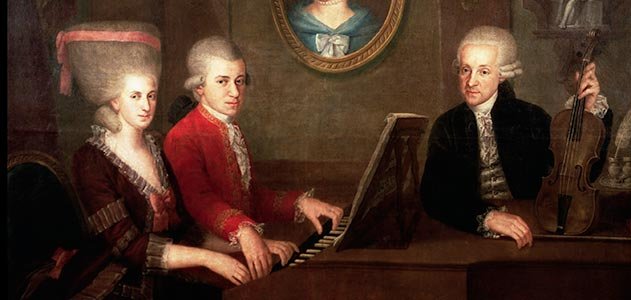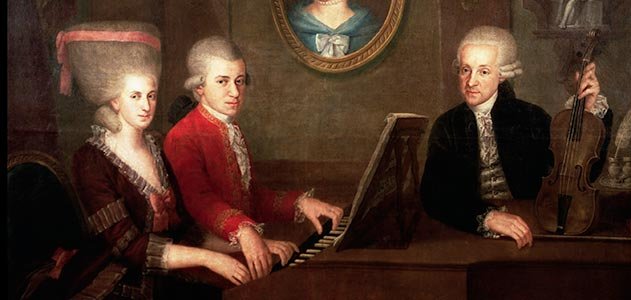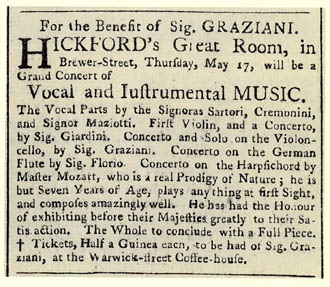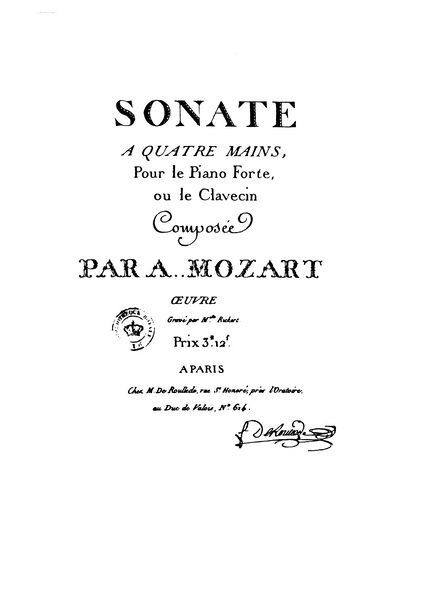Another many-hands-on-the-keyboard post as I research my next Concert Preview for the La Jolla Music Society, mentioned yesterday: “Two Pianos, Three Composers, and Four Hands,“ I came across the following quote:
It could be said that the history of the four-hand recital began on May 13, 1765 in Hickford’s Great Room in London. That was when and where 9-year-old Wolfgang Mozart and his sister, Maria Anna (“Nannerl”) played together. And musicologists think this a four-hand Sonata in C (K. 19d) was probably written for this occasion. This was the first public duet recital on record and precedes by three years the first piano solo recital, which Johann Christian Bach presented in 1768.
“Fresh, fluent, and imaginative” says one author; others are less convinced. In his book “Mozart’s Piano Music,” William Kinderman writes, “…we shall not regard K. 19d as a piece that probably does not stem from Mozart, despite its longstanding association with his oeuvre. The piece still merits consideration as an early example of the piano-duet idiom.”
Though publication of this particular sonata came much later. The credit for that, surprisingly, goes to Charles Burney…”a minor composer whose music is forgotten today. However, he is indispensable to eighteenth century music history as a writer about music and the music scene of his time,” as says the All Music Guide. Burney’s Four Sonatas or Due, for Two Performers on One Piano Forte or Harpsichord, was published in London in 1777. In this case, what’s far more important than the music is the preface that Burney writes, wherein he lays out the case for piano four-hands versus two keyboards. (Bearing in mind of course his goal is to sell more copies of his music “for two performers on One Piano Forte”). But here Burney pretty much lays out the case for the piano duet that will later prove to be so financially viable for Messrs Mendelssohn, Brahms, Dvorak et al:
As the following pieces are the first to have appeared in print, of this kind, it may be necessary to say something concerning their utility, and the manner of performing them.
Burney goes on:
That great and varied effects may be produced by Duets Upon Two keyed-Instruments has been proved by several ingenious compositions, some of which have been published in Germany; but the inconvenience of having Two Harpsichords, or Two Piano-Fortes, and the short time they remain exactly in tune together, have prevented frequent trials, and even the cultivation of this species of music, notwithstanding all of the other advantages, which, in other respects, it offers to musical students. The playing Duets by two persons upon One instrument, however, is attended with nearly as many advantages, without the inconvenience of crowding a room, or of frequent or double-tuning…
And though, at first, the near approach of the hands of the different performers may seem awkward and embarrassing, a little use and contrivance with respect to placing them, and the choice of the fingers, will soon remove that difficulty.
The whole preface is worth reading. Check it out here. So, Mozart made the music; Burney made the case. Smart. Very Smart. Check out a couple of videos below of the history-making K. 19d. I love the randomness of the Toronto shopping mall food court in the former, and the Mozartean ages of the Japanese tykes in the latter….




Be First to Comment